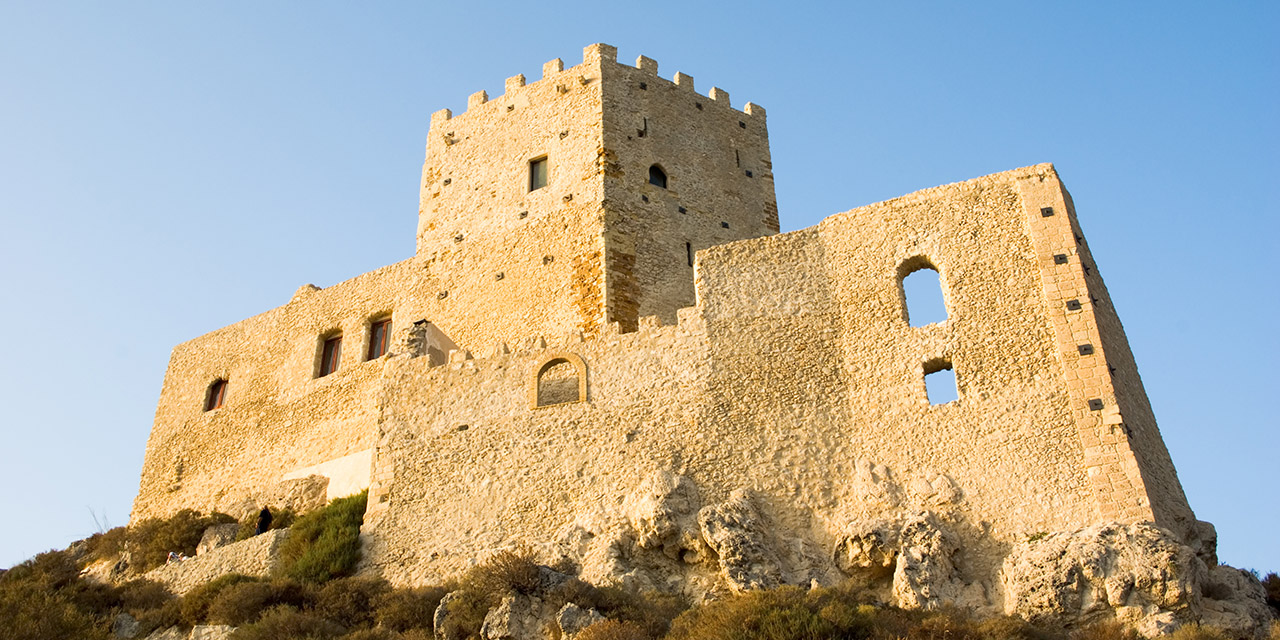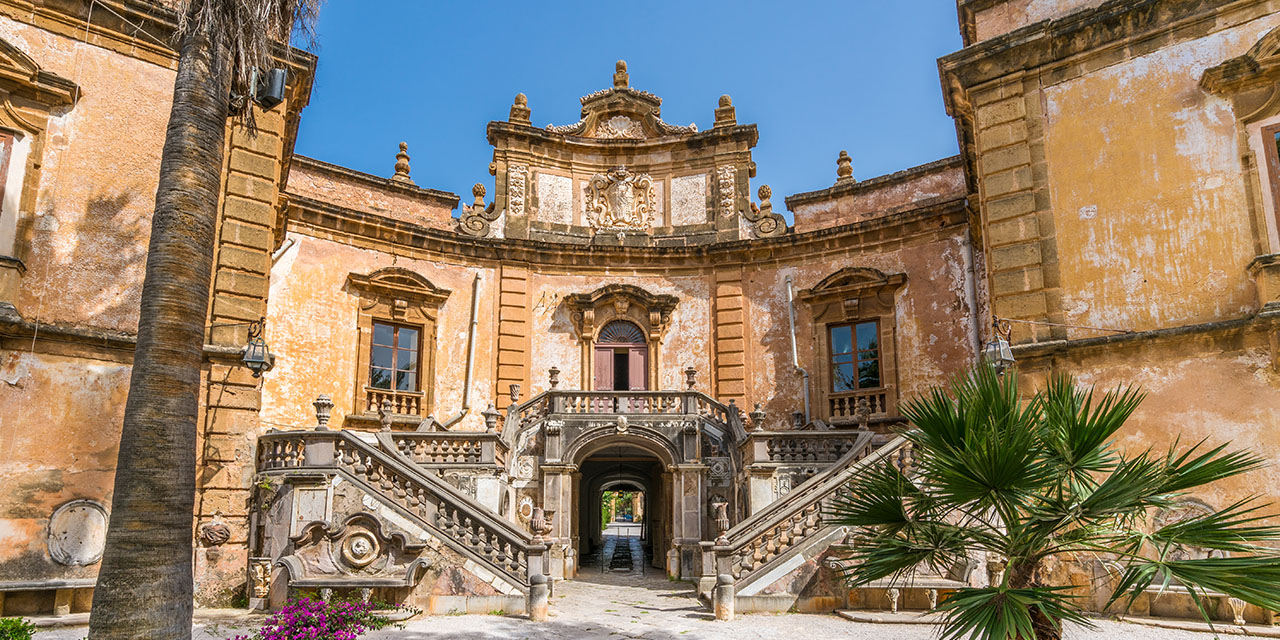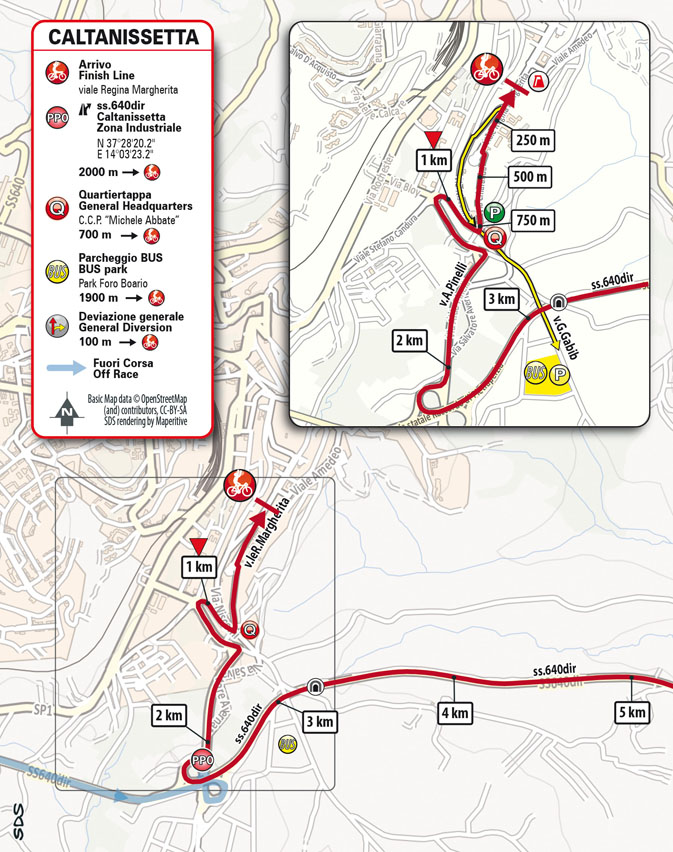profile
map
technical info
The route
This challenging stage undulates continuously along wide roads, through the inland. Mazzarino, Barrafranca and Enna are the only three urban areas along the route. Here, the roads are narrow at points. KOM points are up for grabs in Enna, at the top of the climb leading to the town centre. The stage finale is played out on wide and well-paved roads, with a short climb leading all the way to the finish, in Caltanissetta.
Final kilometres
The route leaves the trunk road, heading for the town centre. The last 3 km ascend slightly with mild gradients (less than 2%). The home straight (500 m) is on wide tarmac.
start / finish
final kilometres
itinerary timetable
tourist info
Host city:
Palma di Montechiaro
Overview
Palma di Montechiaro, the city of the ‘Gattopardo’ made famous by the novel by Giuseppe Tomasi di Lampedusa, is a place rich in history. The discovery of archaeological finds dating back to the second millennium BC and the presence of Sicilian tombs show that the inhabitants were dedicated to agriculture and sheep farming. The first act in the history of Palma is the construction of the Castle by Frederick Prefoglio and that soon passed to the Chiaramonte family from whom it took its name. The act of foundation of the city of Palma is dated April 25, 1637. The first inhabitants of Palma came from Ragusa, hometown of the Tomasi family. To defend the city from the attacks of Saracen pirates, Duke Charles had a defensive tower erected. The city was built following an ‘orthogonal mesh plan’. Countless were the philanthropic initiatives of the Tomasi family, so much so that the first Duke of Palma, Giulio, for his religiousness deserved the name of ‘Holy Duke’.
The latter had the Church of Santa Maria della Luce built on the small hill called ‘il Calvario’ and created a Via Crucis that represented Jesus’ journey from Pilate’s palace to Golgotha. The first home of the Tomasi family in Palma is the Ducal Palace, which in 1659 was transformed into a Benedictine Monastery to accommodate the daughters and the wife of the ‘Holy Duke’. Adjacent to the Monastery is the small church of Maria Santissima del Rosario. Both are fine examples of Sicilian Baroque.
Ph. Credits Comune di Palma di Montechiaro
Food
Palma di Montechiaro, or rather the places of the Leopard, a land where the ancient tradition of Sicilian convent sweets is handed down.
The nuns prepare the typical sweets of the tradition of Palma such as the famous ‘Ricci’ cookies of the Gattopardo made with almonds, but not only: you can taste the ‘muccuneddi’, made with real almond and citron paste, plus soft nougats with almonds and pistachios. These are recipes of typical sweets that came to life within the silent walls of the monasteries and that, still today, are prepared with care.
Goodness and sweetness, a panacea for the body and for the spirit. The sweets are prepared in the convent every week and the trays are sold through a wheel that also allows people to receive gifts. The nuns, in fact, live on charity and offerings and the sale of sweets is a way to sustain themselves.
A specialty apart are the ‘Umberto cookies’ dedicated to the King of Italy Umberto I of Savoy, which are made in thick and soft strips “like the King’s moustache”, and sprinkled with abundant icing sugar. The latter can be found on sale in local pastry shops.
Among the typical dishes of the gastronomy of Palmese we list:
- Busiati with pork ragout
- Cucciddateddi (sweets with figs)
- Salad of oranges
- Risu da Vigilia di Natali (Christmas Eve rice)
- Eggplant pie
Ph. Credits Comune di Palma di Montechiaro
Wines & Beverage
In the commune of Palma di Montechiaro viticulture has a prestigious position among the agricultural activities and the wines produced, extending as far as the fields of Licata and Campobello di Mazara, are renowned for their originality and quality. Local producers have looked for the best positions for their vineyards in order to get grapes suitable for the production of wines in line with the high standards present in the province. The vicinity of the town to the sea and the salty breeze contribute to give wines of this area the characteristic minerality which distinguishes them.
A typical wine produced with grapes from this area is ‘Grillo’, with a straw yellow color and a floral bouquet with notes of white flowers, such as daisy and jasmine: to the palate it is warm, balanced and harmonic with a dry and slightly tannic taste. Its right acidity makes it particularly suited for aging.
Points of interest
1) The Mother Church, emblem and valuable reality of the city, which dates back to the seventeenth century. Expression of Sicilian Baroque, from the top of a wide and artistic staircase, it emanates the charm of its grandeur. The interior, with three naves, hosts rich neoclassical decorations, paintings, canvases of refined quality, as well as numerous relics of saints. At the end, the naves welcome the presbytery framed by gratings of singular beauty and two chapels dedicated to the Holy Sacrament and the Madonna del Rosario.
2) Ducal Palace or of the Leopard. Built after the inclusion of the first in the Benedictine Monastery (1653 / 1659), has been restored and returned to its original splendor. The external appearance is simple and austere while the interior is characterized by the refinement of the coffered ceilings in painted wood. Particularly decorative and of exquisite workmanship are the ceilings of the Halls of Arms, that of the Military and Religious Orders, and that which represents the Ducal Coat of Arms of the Tomasi family. The ceiling of the corner room stands out for its magnificence and refined decorative elegance, and depicts the distinctive noble signs of the Tomasi family. Described by Giuseppe Tomasi Di Lampedusa in his famous novel “Il Gattopardo” (The Leopard), it is universally known and admired.
3) Benedictine Monastery: inserted on a semicircular staircase that gives it a bizarre architectural appearance, it was built between 1653 and 1659 with the inclusion of the first ducal palace. Visitors have the privilege to admire the many treasures kept in the monastery, first of all the Church with its magnificent lacunar ceiling, paintings, statues, sacred vestments richly and skillfully embroidered. But what mostly involves and marks is the visit to the cell of the “Venerable” Sister Crocifissa, born Isabella, daughter of Giulio Tomasi. The nuns are careful custodians of her remains and numerous relics, including a fragment of the cross of Jesus. They are offered to the admiration of visitors precious sacred vestments and a letter that the devil wanted to be signed by the Venerable and the stone that she threw at him.
There are numerous churches in Palma di Montechiaro, a tangible sign of the religious spirit that guided the work of the Tomasi family.
4) The Church of the College of Mary (18th century) which houses a copy of the Holy Shroud, previously kept in the chapel of Calvary.
5) The Church of the Purgatory (1646), with its artistic baroque portal, which welcomes visitors in a dimension of bright and spirituality.
6) The Church of the Holy Family (XVIIIsec.) that incorporated to the palace of the Scolopi shares space, style and history.
7) Seat of the Municipality – the Palace of the Scolopi, in baroque style, completed in 1712. Handed over to the care of the Scolopi Fathers, initially it was used as the Institute of the Scuole Pie (Pious Schools) to become in 1800 the seat of a prestigious university attended by the young people of the Sicilian nobility.
8) At the end of this path is the Church of Sant’Angelo (XVIII sec.) dedicated to the patron saint of Licata. Giuseppe Maria Tomasi had built next to it an orphanage for small orphans, later transferred and housed at the College of Mary.
9) Finished the visit to the ancient city, you can not neglect the opportunity to take a regenerating bath at the beautiful beaches surrounding Palma di Montechiaro: Ciotta Beach – Cala Vincenzina – Marina di Palma Beach – Castellazzo Beach – Malerba Beach and finally, not far away, the suggestive ‘Punta Bianca’.
Ph. Credits Comune di Palma di Montechiaro
Caltanissetta
Touristic information
The city, a provincial capital in the hinterland of Sicily, offers the opportunity to discover something new about the island. Nature, art, history and food are the four cardinal points that lead us straight to Caltanissetta.
The name Caltanissetta comes from Arabic, Qal’at an-Nisa, which can be translated into “women’s castle” (or fortress), as the town was thought to be the former harem of the Emir of Palermo or, more likely, to be inhabited mostly by women whose men went away to work in the fields. The ancient fortress with red brick towers, also called the Pietrarossa Castle, stands on a cliff overlooking the valley below.
Ph. Credits Luca Miccichè
Gastronomy
Local cuisine has always been based on staple foodstuffs that came from agriculture, which are now increasingly popular in the gourmet culinary scene.
Traditional specialties include the Slow Food heritage Cuddrureddra di Delia, which are exquisite deep-fried carnival cookies, now available all year round.
If you have a sweet tooth, you’ll love the traditional cubaita (an almond, pistachio and sesame nougat bar with honey and candied sugar), a favourite treat of the Italian writer Andrea Camilleri.
The village of Santa Rita, a small cluster of hoses nestled in the nearby countryside, is well worth a visit. Here, you can treat your taste buds to the local bakery products made using flour and yeast coming from heritage wheat varieties, enjoy a relaxing day in the village, and visit the modern Micro Museo Immateriale del Grano e del Pane (wheat and bread museum).
A bike ride through the cornfields and the peach orchards is also a great way to spend the day.
Ph. Credits Paolo Barone
Points of interest
The imposing Fontana del Tritone dominates the central Piazza Garibaldi. The fountain, designed by the architect Michele Averna and carved by the local sculptor Michele Tripisciano, depicts a bronze horse tamed by a triton, and threatened by two sea monsters.
Behind the fountain stands the cathedral of Santa Maria La Nova, built in 1570. The church has a three-nave Latin-cross floorplan, with four chapels on each side. The interior is decorated with beautiful trompe-l’œil frescoes by the Flemish painter Guglielmo Borremans, and with numerous paintings and sculptures. Particularly notable are “The Madonna del Carmine” by the Tuscan painter Filippo Paladini, the canvases by the local artist Vincenzo Roggeri, and a sculpture of St. Michael the Archangel by S. Li Volsi. The statue is carried in procession across the city streets each year on September 29 to celebrate the patron saint.
A walk through the old town offers marvellous views of lavish buildings that nobles and rulers had built through the ages.
The beautiful Teatro Regina Margherita (1870) is one of the oldest theatres on the island, and the main highlight along Corso Vittorio Emanuele. After lengthy restoration works, the theatre has finally come back to life as an art stage.
The Corso is bordered on one side by the Church of Santa Croce, formerly a Benedictine monastery and, on the other side, by the shopping district, with showrooms and stores aplenty, for a nice and relaxed walk. Bursting with colour and flavour, at the heart of the old town, Via Consultore Benintende has been the seat of an ancient market since the late 18th century – the Strata ‘a foglia, crammed with stalls selling fruit and vegetables, cheeses, legumes and giftware, and with bakeries, fish and butcher shops, and exotic food stores.
The 18-century Palazzo Natale Cosentino is one of the highlights of the old San Rocco quarter, near the market. The town hall, housed inside Palazzo del Carmine, stands at the intersection of Corso Vittorio Emanuele and Corso Umberto I. The imposing Palazzo Moncada, currently a theatre, multiplex cinema and civic museum, is a little further away, on the Salita Matteotti.
The church of Sant’Agata al Collegio looks majestic on the outside, with two flights of stairs that branch off from the central staircase. The interior details – which include polychrome marble and stunning frescoes, some by Borremans – are equally remarkable.
The Diocesan Museum of the Bishop’s seminary, inside the grand Bishop’s Palace, is a collection of over 500 pieces dating to the 15th-21st centuries, with a dedicated department for contemporary art.
The church of Santo Spirito, built over a former Arab fortress in 1095, has a modest and unadorned Romanesque structure. The quadrangular tower, the narrow windows and the pointed arches all speak to a Moorish legacy. Inside, main highlights include a painting of the Christ Pantocrator, a stone baptismal font, a rare 12-century tin chalice, a 15-century crucifix called “crocifisso dello Staglio”, a marble funerary urn with inscriptions dating to the Roman period, beautiful frescoes and a 16-century polychrome terracotta statue of Our Lady of Graces.
The Regional Archaeological Museum of Caltanissetta, a collection of Neolithic finds from the surrounding archaeological sites, is some 150 metres away.
The Mineral Museum of Caltanissetta holds a large collection of minerals, as well as a permanent exhibition about sulphur mining technology in Sicily. The Gessolungo and Trabonella mines, visible from the outside, offer stunning views of the surrounding countryside.
Customs
Sicily is a land known for its countless religious festivals, which come from ancient rituals that are often connected to agriculture. The Holy Week, which includes processions and rituals taking place from Palm Sunday to Easter day, is a heartfelt celebration for the local population.
On Good Friday, the city attends to the Black Christ procession, the most important and fascinating ritual march. The Black Christ is an 85-cm tall wooden crucifix that was found inside a cave (and no matter how many times it was cleaned, it would become dark again, hence the name), and which is thought to work wonders.
The Museo delle Vare, currently located in the basement of the church of San Pio X, well deserves a visit. The museum holds a collection of 15 groups of statues representing the passion and death of Jesus, called the ‘Vare’, which were carved in the late 1800s for the Maundy Thursday procession.
Ph. Credits Luca Miccichè


























































